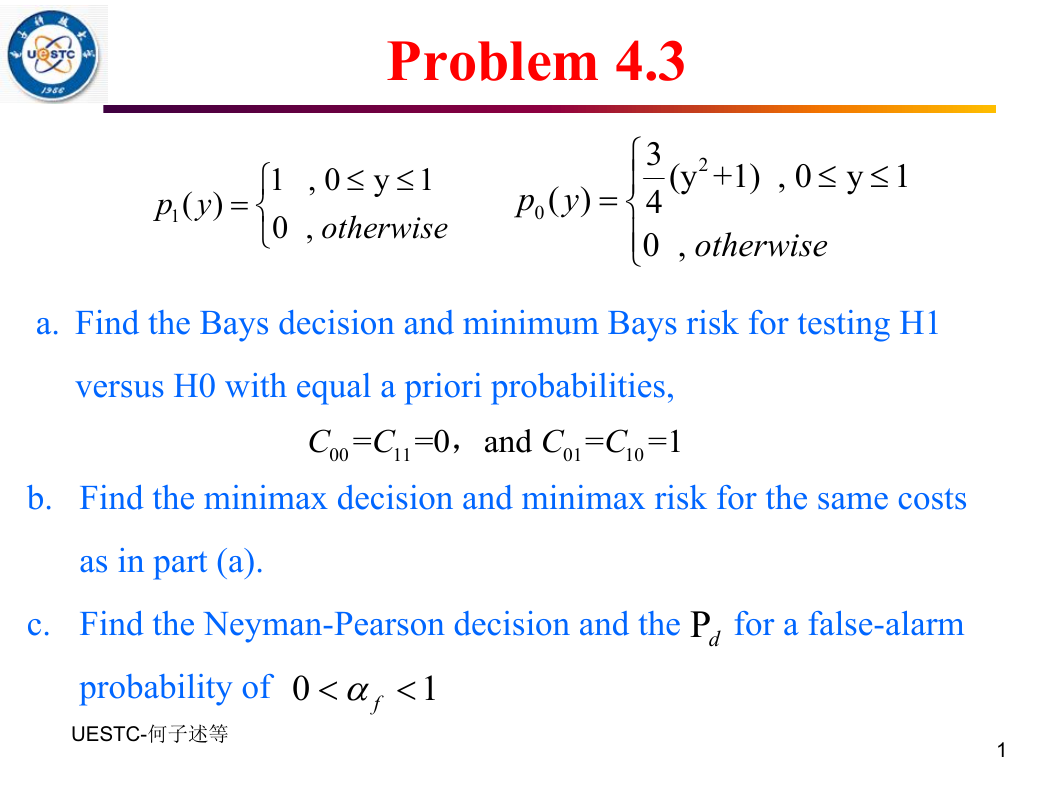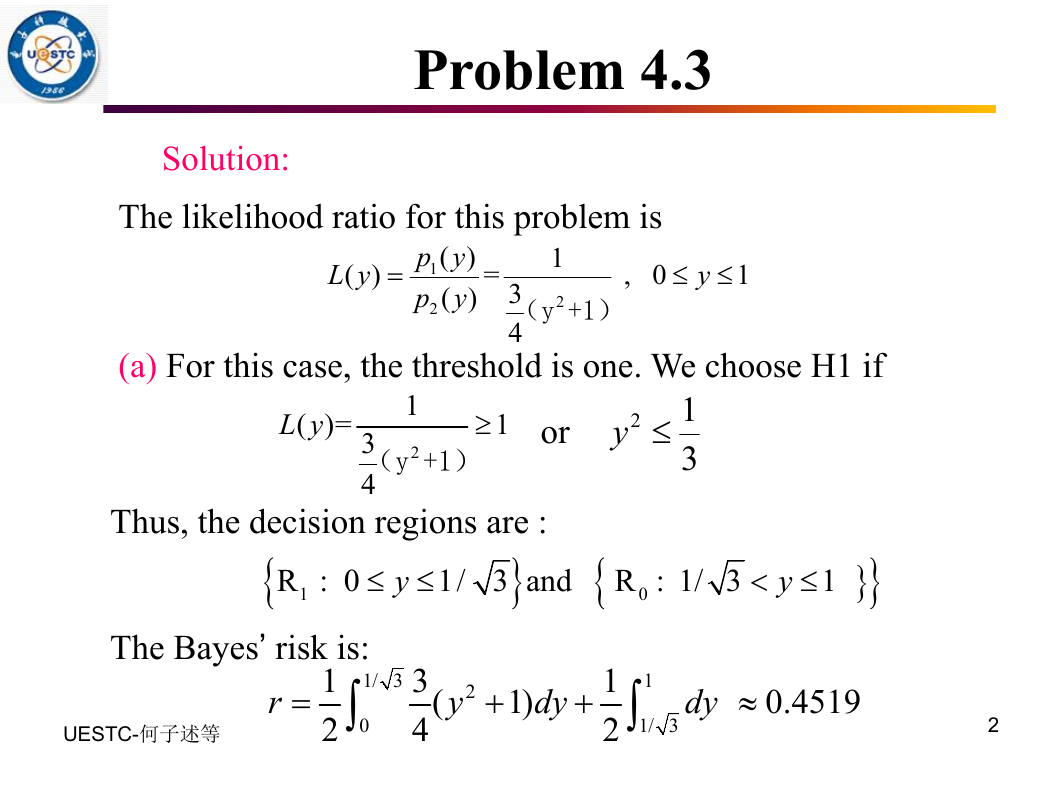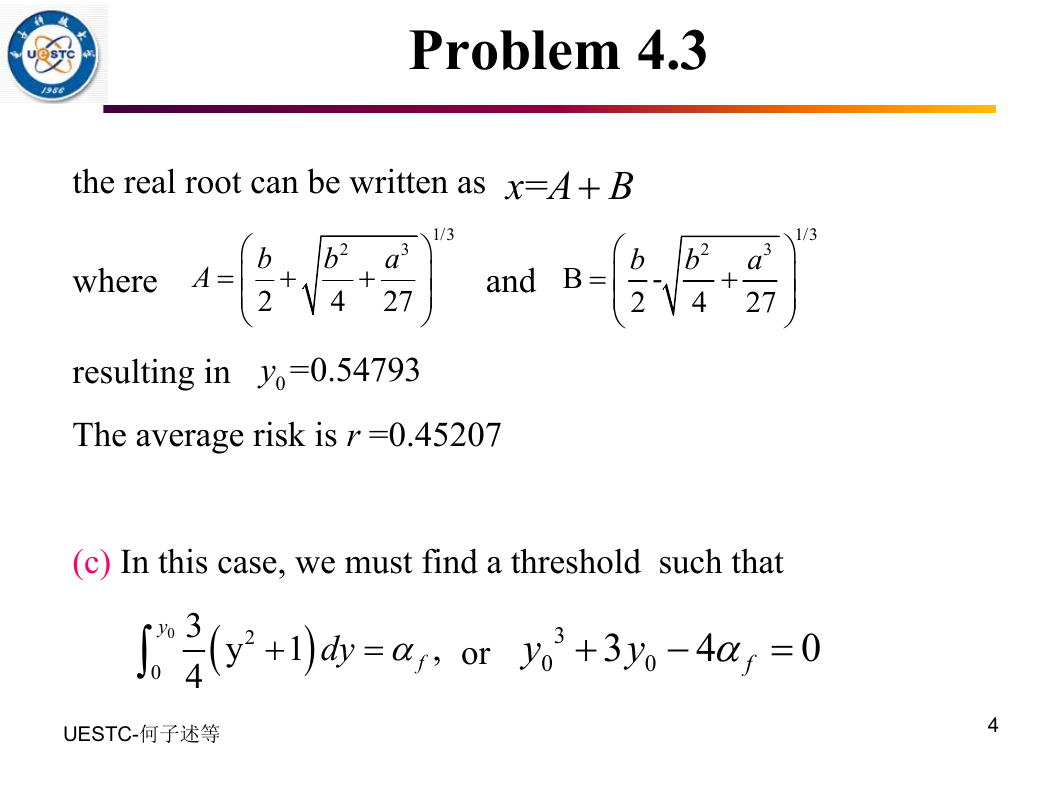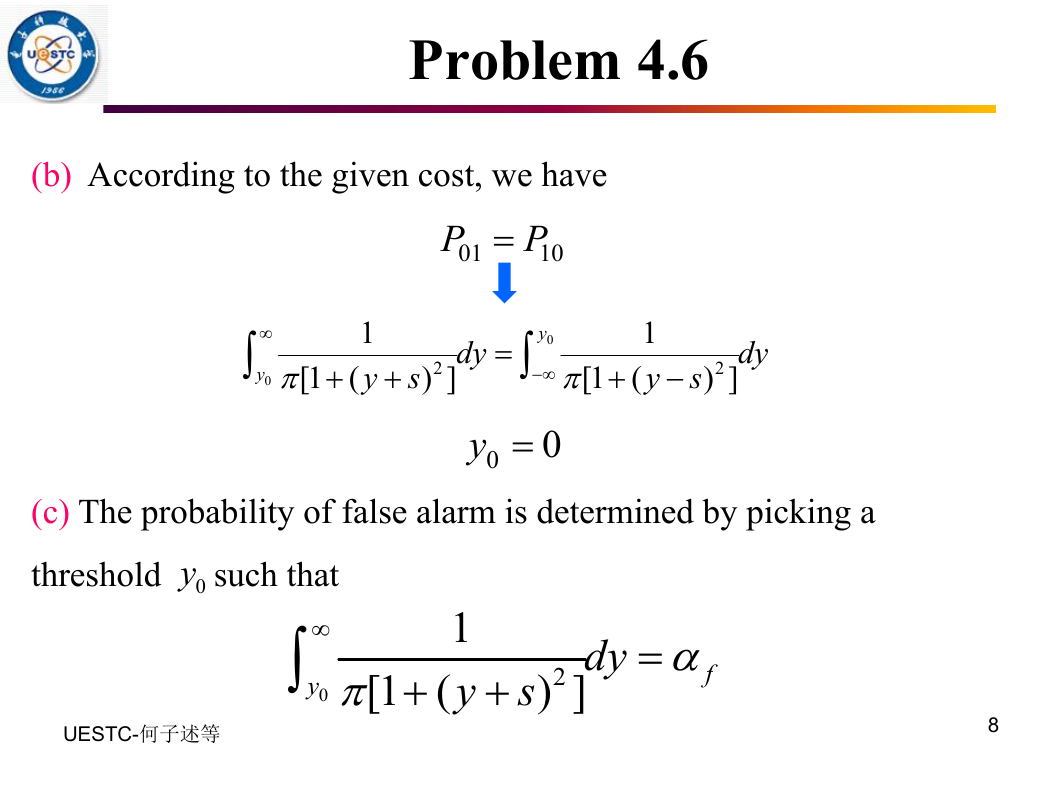Problem 4.3
( )
p y
1
1 , 0
0 ,
y 1
otherwise
( )
p y
0
2
3 (y +1) , 0
4
0 ,
otherwise
y 1
a. Find the Bays decision and minimum Bays risk for testing H1
versus H0 with equal a priori probabilities,
=1
and
C C
11
=0
,
C C
10
=
01
=
00
b. Find the minimax decision and minimax risk for the same costs
as in part (a).
c. Find the Neyman-Pearson decision and the for a false-alarm
Pd
probability of
UESTC-何子述等
0
f
1
1
�
Problem 4.3
Solution:
The likelihood ratio for this problem is
, 0
( )
L y
=
( )
p y
1
( )
p y
2
1
2
3
(y +1)
4
y
1
(a) For this case, the threshold is one. We choose H1 if
( )=
L y
1
2
3
(y +1)
4
1
or
2
y
1
3
Thus, the decision regions are :
R : 0
The Bayes’ risk is:
R : 1/ 3
1/ 3 and
0.4519
y
1)
dy
dy
1
2
(
y
r
1/ 3
1
1/ 3
y
1
0
2
1
2
0
3
4
1
2
UESTC-何子述等
�
Problem 4.3
(b) For this part, we want to find a threshold such that the two
conditional risks are equal, i.e.,
y
0
0
3(
4
2
y
1)
dy
=
1
y
0
dy
Solving this, we arrive at a cubic equation which must solve, namely
3
y
0
07
y
4 0
Two of the solutions are imaginary, and thus unacceptable. If we
model the cubic equation as
ax b
0
UESTC-何子述等
3
x
3
�
Problem 4.3
the real root can be written as =x A B
b
2
where
and
b
2
B
A
-
2
b
4
3
a
27
1/3
2
b
4
1/3
3
a
27
0=0.54793
y
resulting in
The average risk is r =0.45207
(c) In this case, we must find a threshold such that
y
0
3 y
4
UESTC-何子述等
0
2
1
dy
f
,
or
3
y
0
03
y
f
4
0
4
�
Problem 4.3
The solution is
where
and
A
f
2
0=y A B
2
B
f
2
4
f
2
4
f
1/3
1
1/3
1
The probability of detection is
dP
y
0
0
dy
y
0
UESTC-何子述等
5
�
Problem 4.6
Repeat Problem 4.3for the hypothesis
H
1 : y = s + n,
where s is a fixed real positive number and n has a pdf :
H
0 : y = s + n
( )
p n
1
n
(1
2
)
Solution :
p y H
1
1
y
2
s
1
p y H
0
1
y
2
s
1
UESTC-何子述等
( )
L y
1 (
1 (
y
y
2
2
s
s
)
)
6
�
Problem 4.6
(a) With equal a priori probabilities and uniform costs, we make
D1 decision if
As s is positive
The Bayes’ risk is then
L y
1
ys
0
y
D
1
D
0
0
r
1
2
0
1
y
dy
2
) ]
s
1
2
[1 (
0
1
[1 (
y
dy
2
) ]
s
1
2
s
1
tan
UESTC-何子述等
7
�
Problem 4.6
(b) According to the given cost, we have
P
01
P
10
y
0
[1 (
1
y
dy
2
) ]
s
y
0
1
[1 (
y
dy
2
) ]
s
0
y
0
(c) The probability of false alarm is determined by picking a
threshold such that
f
dy
0y
1
[1 (
y
s
2
) ]
y
0
UESTC-何子述等
8
�
















 2023年江西萍乡中考道德与法治真题及答案.doc
2023年江西萍乡中考道德与法治真题及答案.doc 2012年重庆南川中考生物真题及答案.doc
2012年重庆南川中考生物真题及答案.doc 2013年江西师范大学地理学综合及文艺理论基础考研真题.doc
2013年江西师范大学地理学综合及文艺理论基础考研真题.doc 2020年四川甘孜小升初语文真题及答案I卷.doc
2020年四川甘孜小升初语文真题及答案I卷.doc 2020年注册岩土工程师专业基础考试真题及答案.doc
2020年注册岩土工程师专业基础考试真题及答案.doc 2023-2024学年福建省厦门市九年级上学期数学月考试题及答案.doc
2023-2024学年福建省厦门市九年级上学期数学月考试题及答案.doc 2021-2022学年辽宁省沈阳市大东区九年级上学期语文期末试题及答案.doc
2021-2022学年辽宁省沈阳市大东区九年级上学期语文期末试题及答案.doc 2022-2023学年北京东城区初三第一学期物理期末试卷及答案.doc
2022-2023学年北京东城区初三第一学期物理期末试卷及答案.doc 2018上半年江西教师资格初中地理学科知识与教学能力真题及答案.doc
2018上半年江西教师资格初中地理学科知识与教学能力真题及答案.doc 2012年河北国家公务员申论考试真题及答案-省级.doc
2012年河北国家公务员申论考试真题及答案-省级.doc 2020-2021学年江苏省扬州市江都区邵樊片九年级上学期数学第一次质量检测试题及答案.doc
2020-2021学年江苏省扬州市江都区邵樊片九年级上学期数学第一次质量检测试题及答案.doc 2022下半年黑龙江教师资格证中学综合素质真题及答案.doc
2022下半年黑龙江教师资格证中学综合素质真题及答案.doc